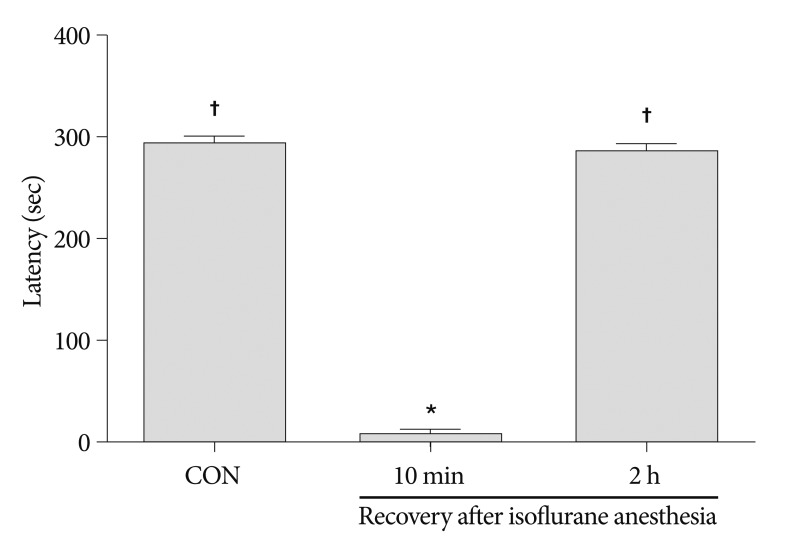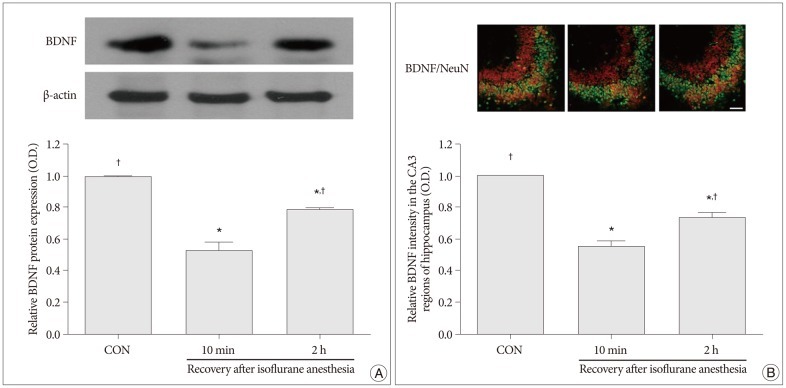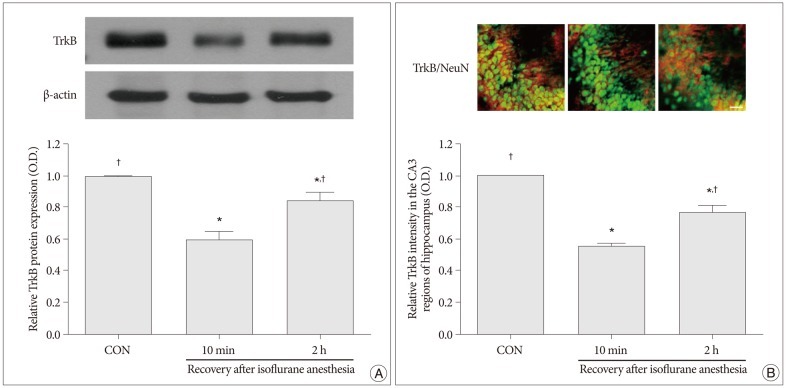J Korean Neurosurg Soc.
2013 Mar;53(3):139-144. 10.3340/jkns.2013.53.3.139.
Isoflurane Induces Transient Anterograde Amnesia through Suppression of Brain-Derived Neurotrophic Factor in Hippocampus
- Affiliations
-
- 1Department of Emergency Medicine, Korea University College of Medicine, Ansan Hospital, Ansan, Korea.
- 2Department of Physical Therapy, Kyungnam University, Changwon, Korea.
- 3Department of Neurosurgery, Kyung Hee University College of Medicine, Kyung Hee University Hospital at Gangdong, Seoul, Korea.
- 4Department of Anesthesiology and Pain Medicine, Kyung Hee University College of Medicine, Kyung Hee University Hospital at Gangdong, Seoul, Korea. mdyjwchk@khu.ac.kr
- KMID: 2190737
- DOI: http://doi.org/10.3340/jkns.2013.53.3.139
Abstract
OBJECTIVE
Transient anterograde amnesia is occasionally observed in a number of conditions, including migraine, focal ischemia, venous flow abnormalities, and after general anesthesia. The inhalation anesthetic, isoflurane, is known to induce transient anterograde amnesia. We examined the involvement of brain-derived neurotrophic factor (BDNF) and its receptor tyrosine kinase B (TrkB) in the underlying mechanisms of the isoflurane-induced transient anterograde amnesia.
METHODS
Adult male Sprague-Dawley rats were divided into three groups : the control group, the 10 minutes after recovery from isoflurane anesthesia group, and the 2 hours after recovery from isoflurane anesthesia group (n=8 in each group). The rats in the isoflurane-exposed groups were anesthetized with 1.2% isoflurane in 75% nitrous oxide and 25% oxygen for 2 hours in a Plexiglas anesthetizing chamber. Short-term memory was determined using the step-down avoidance task. BDNF and TrkB expressions in the hippocampus were evaluated by immunofluorescence staining and western blot analysis.
RESULTS
Latency in the step-down avoidance task was decreased 10 minutes after recovery from isoflurane anesthesia, whereas it recovered to the control level 2 hours after isoflurane anesthesia. The expressions of BDNF and TrkB in the hippocampus were decreased immediately after isoflurane anesthesia but were increased 2 hours after isoflurane anesthesia.
CONCLUSION
In this study, isoflurane anesthesia induced transient anterograde amnesia, and the expressions of BDNF and TrkB in the hippocampus might be involved in the underlying mechanisms of this transient anterograde amnesia.
Keyword
MeSH Terms
-
Adult
Amnesia, Anterograde
Anesthesia
Anesthesia, General
Animals
Blotting, Western
Brain-Derived Neurotrophic Factor
Fluorescent Antibody Technique
Hippocampus
Humans
Inhalation
Ischemia
Isoflurane
Male
Memory, Short-Term
Migraine Disorders
Nitrous Oxide
Oxygen
Polymethyl Methacrylate
Protein-Tyrosine Kinases
Rats
Rats, Sprague-Dawley
Brain-Derived Neurotrophic Factor
Isoflurane
Nitrous Oxide
Oxygen
Polymethyl Methacrylate
Protein-Tyrosine Kinases
Figure
Reference
-
1. Alonso M, Vianna MR, Depino AM, Mello e Souza T, Pereira P, Szapiro G, et al. BDNF-triggered events in the rat hippocampus are required for both short- and long-term memory formation. Hippocampus. 2002; 12:551–560. PMID: 12201640.
Article2. Arancio O, Chao MV. Neurotrophins, synaptic plasticity and dementia. Curr Opin Neurobiol. 2007; 17:325–330. PMID: 17419049.
Article3. Bartsch T, Schönfeld R, Müller FJ, Alfke K, Leplow B, Aldenhoff J, et al. Focal lesions of human hippocampal CA1 neurons in transient global amnesia impair place memory. Science. 2010; 328:1412–1415. PMID: 20538952.
Article4. Bliss TV, Collingridge GL. A synaptic model of memory : long-term potentiation in the hippocampus. Nature. 1993; 361:31–39. PMID: 8421494.
Article5. Bortolon RJ, Weglinski MR, Sprung J. Transient global amnesia after general anesthesia. Anesth Analg. 2005; 101:916–919. PMID: 16116014.
Article6. Cunha C, Brambilla R, Thomas KL. A simple role for BDNF in learning and memory? Front Mol Neurosci. 2010; 3:1. PMID: 20162032.
Article7. Dutton RC, Maurer AJ, Sonner JM, Fanselow MS, Laster MJ, Eger EI 2nd. Isoflurane causes anterograde but not retrograde amnesia for pavlovian fear conditioning. Anesthesiology. 2002; 96:1223–1229. PMID: 11981164.
Article8. Jia F, Pignataro L, Harrison NL. GABAA receptors in the thalamus : alpha4 subunit expression and alcohol sensitivity. Alcohol. 2007; 41:177–185. PMID: 17521848.
Article9. Kesner RP, Goodrich-Hunsaker NJ. Developing an animal model of human amnesia : the role of the hippocampus. Neuropsychologia. 2010; 48:2290–2302. PMID: 19883669.
Article10. Kim H, Lee SH, Kim SS, Yoo JH, Kim CJ. The influence of maternal treadmill running during pregnancy on short-term memory and hippocampal cell survival in rat pups. Int J Dev Neurosci. 2007; 25:243–249. PMID: 17434282.
Article11. Kim SE, Ko IG, Kim BK, Shin MS, Cho S, Kim CJ, et al. Treadmill exercise prevents aging-induced failure of memory through an increase in neurogenesis and suppression of apoptosis in rat hippocampus. Exp Gerontol. 2010; 45:357–365. PMID: 20156544.
Article12. Kohara K, Kitamura A, Morishima M, Tsumoto T. Activity-dependent transfer of brain-derived neurotrophic factor to postsynaptic neurons. Science. 2001; 291:2419–2423. PMID: 11264540.
Article13. Koponen E, Võikar V, Riekki R, Saarelainen T, Rauramaa T, Rauvala H, et al. Transgenic mice overexpressing the full-length neurotrophin receptor trkB exhibit increased activation of the trkB-PLCgamma pathway, reduced anxiety, and facilitated learning. Mol Cell Neurosci. 2004; 26:166–181. PMID: 15121188.
Article14. Lee E, Son H. Adult hippocampal neurogenesis and related neurotrophic factors. BMB Rep. 2009; 42:239–244. PMID: 19470236.
Article15. Lu LX, Yon JH, Carter LB, Jevtovic-Todorovic V. General anesthesia activates BDNF-dependent neuroapoptosis in the developing rat brain. Apoptosis. 2006; 11:1603–1615. PMID: 16738805.
Article16. Lu Y, Christian K, Lu B. BDNF : a key regulator for protein synthesis-dependent LTP and long-term memory? Neurobiol Learn Mem. 2008; 89:312–323. PMID: 17942328.
Article17. Ma YL, Wang HL, Wu HC, Wei CL, Lee EH. Brain-derived neurotrophic factor antisense oligonucleotide impairs memory retention and inhibits long-term potentiation in rats. Neuroscience. 1998; 82:957–967. PMID: 9466420.
Article18. Martin SJ, Grimwood PD, Morris RG. Synaptic plasticity and memory : an evaluation of the hypothesis. Annu Rev Neurosci. 2000; 23:649–711. PMID: 10845078.19. Minichiello L, Korte M, Wolfer D, Kühn R, Unsicker K, Cestari V, et al. Essential role for TrkB receptors in hippocampus-mediated learning. Neuron. 1999; 24:401–414. PMID: 10571233.
Article20. Mizuno M, Yamada K, Olariu A, Nawa H, Nabeshima T. Involvement of brain-derived neurotrophic factor in spatial memory formation and maintenance in a radial arm maze test in rats. J Neurosci. 2000; 20:7116–7121. PMID: 10995859.
Article21. Mu JS, Li WP, Yao ZB, Zhou XF. Deprivation of endogenous brain-derived neurotrophic factor results in impairment of spatial learning and memory in adult rats. Brain Res. 1999; 835:259–265. PMID: 10415381.
Article22. Munte S, Schmidt M, Meyer M, Nager W, Lüllwitz E, Münte TF, et al. Implicit memory for words played during isoflurane- or propofol-based anesthesia : the lexical decision task. Anesthesiology. 2002; 96:588–594. PMID: 11873032.23. Murer MG, Yan Q, Raisman-Vozari R. Brain-derived neurotrophic factor in the control human brain, and in Alzheimer's disease and Parkinson's disease. Prog Neurobiol. 2001; 63:71–124. PMID: 11040419.
Article24. Perouansky M, Rau V, Ford T, Oh SI, Perkins M, Eger EI 2nd, et al. Slowing of the hippocampal θ rhythm correlates with anesthetic-induced amnesia. Anesthesiology. 2010; 113:1299–1309. PMID: 21042201.
Article25. Pietropaolo S, Paterna JC, Büeler H, Feldon J, Yee BK. Bidirectional changes in water-maze learning following recombinant adenovirus-associated viral vector (rAAV)-mediated brain-derived neurotrophic factor expression in the rat hippocampus. Behav Pharmacol. 2007; 18:533–547. PMID: 17762522.
Article26. Rau V, Iyer SV, Oh I, Chandra D, Harrison N, Eger EI 2nd, et al. Gamma-aminobutyric acid type A receptor alpha 4 subunit knockout mice are resistant to the amnestic effect of isoflurane. Anesth Analg. 2009; 109:1816–1822. PMID: 19923508.
Article27. Saarelainen T, Pussinen R, Koponen E, Alhonen L, Wong G, Sirviö J, et al. Transgenic mice overexpressing truncated trkB neurotrophin receptors in neurons have impaired long-term spatial memory but normal hippocampal LTP. Synapse. 2000; 38:102–104. PMID: 10941145.
Article28. Schinder AF, Poo M. The neurotrophin hypothesis for synaptic plasticity. Trends Neurosci. 2000; 23:639–645. PMID: 11137155.
Article29. Shekhar R. Transient global amnesia--a review. Int J Clin Pract. 2008; 62:939–942. PMID: 18248396.30. Sung YH, Shin MS, Cho S, Baik HH, Jin BK, Chang HK, et al. Depression-like state in maternal rats induced by repeated separation of pups is accompanied by a decrease of cell proliferation and an increase of apoptosis in the hippocampus. Neurosci Lett. 2010; 470:86–90. PMID: 20043974.
Article31. Twersky RS, Hartung J, Berger BJ, McClain J, Beaton C. Midazolam enhances anterograde but not retrograde amnesia in pediatric patients. Anesthesiology. 1993; 78:51–55. PMID: 8424571.
Article32. Wade JG, Stevens WC. Isoflurane: an anesthetic for the eighties? Anesth Analg. 1981; 60:666–682. PMID: 7023281.33. Waterhouse EG, Xu B. New insights into the role of brain-derived neurotrophic factor in synaptic plasticity. Mol Cell Neurosci. 2009; 42:81–89. PMID: 19577647.
Article34. Werner DF, Swihart A, Rau V, Jia F, Borghese CM, McCracken ML, et al. Inhaled anesthetic responses of recombinant receptors and knockin mice harboring α2(S270H/L277A) GABA(A) receptor subunits that are resistant to isoflurane. J Pharmacol Exp Ther. 2011; 336:134–144. PMID: 20807777.
Article35. Yu Q, Wang H, Chen J, Gao Y, Liang W. Neuroprotections and mechanisms of inhalational anesthetics against brain ischemia. Front Biosci (Elite Ed). 2010; 2:1275–1298. PMID: 20515801.
- Full Text Links
- Actions
-
Cited
- CITED
-
- Close
- Share
- Similar articles
-
- Anterograde Amnesia after Acute Glufosinate Ammonium Intoxication
- Retrograde Amnesia as a Predominant Symptom of Transient Global Amnesia
- A Case of Anterograde Amnesia with Bilateral Hippocampus Involvement After Acute Glufosinate Ammonium Intoxication
- Transient Global Amnesia Developed after Zolpidem Intake
- Three Cases of Transient Global Amnesia with Focal High Signal Intensity in Hippocampus in Diffusion Weighted Image




